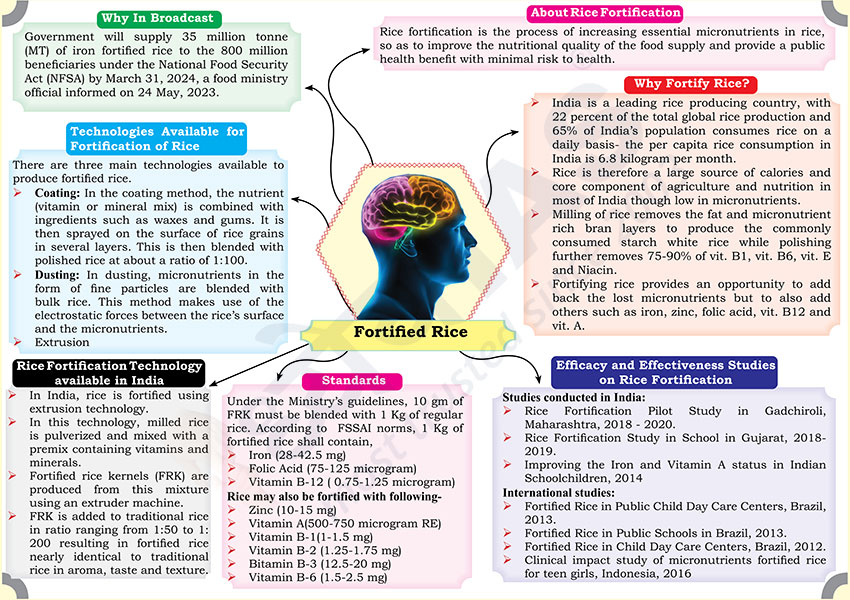Why in Broadcast?
- Government will supply 35 million tonne (MT) of iron fortified rice to the 800 million beneficiaries under the National Food Security Act (NFSA) by March 31, 2024, a food ministry official informed on 24 May, 2023.
About Rice Fortification
- Rice fortification is the process of increasing essential micronutrients in rice, so as to improve the nutritional quality of the food supply and provide a public health benefit with minimal risk to health.
Why Fortify Rice?
- India is a leading rice producing country, with 22 percent of the total global rice production and 65% of India’s population consumes rice on a daily basis- the per capita rice consumption in India is 6.8 kilogram per month.
- Rice is therefore a large source of calories and core component of agriculture and nutrition in most of India though low in micronutrients.
- Milling of rice removes the fat and micronutrient rich bran layers to produce the commonly consumed starch white rice while polishing further removes 75-90% of vit. B1, vit. B6, vit. E and Niacin.
- Fortifying rice provides an opportunity to add back the lost micronutrients but to also add others such as iron, zinc, folic acid, vit. B12 and vit. A.
Efficacy and Effectiveness Studies on Rice Fortification
Studies conducted in India:
- Rice Fortification Pilot Study in Gadchiroli, Maharashtra, 2018 - 2020.
- Rice Fortification Study in School in Gujarat, 2018-2019.
- Improving the Iron and Vitamin A status in Indian Schoolchildren, 2014
International studies:
- Fortified Rice in Public Child Day Care Centers, Brazil, 2013.
- Fortified Rice in Public Schools in Brazil, 2013.
- Fortified Rice in Child Day Care Centers, Brazil, 2012.
- Clinical impact study of micronutrients fortified rice for teen girls, Indonesia, 2016
Standards
- Under the Ministry’s guidelines, 10 gm of FRK must be blended with 1 Kg of regular rice. According to FSSAI norms, 1 Kg of fortified rice shall contain,
- Iron (28-42.5 mg)
- Folic Acid (75-125 microgram)
- Vitamin B-12 ( 0.75-1.25 microgram)
- Rice may also be fortified with following-
- Zinc (10-15 mg)
- Vitamin A(500-750 microgram RE)
- Vitamin B-1(1-1.5 mg)
- Vitamin B-2 (1.25-1.75 mg)
- Bitamin B-3 (12.5-20 mg)
- Vitamin B-6 (1.5-2.5 mg)
Rice Fortification Technology available in India
- In India, rice is fortified using extrusion technology.
- In this technology, milled rice is pulverized and mixed with a premix containing vitamins and minerals.
- Fortified rice kernels (FRK) are produced from this mixture using an extruder machine.
- FRK is added to traditional rice in ratio ranging from 1:50 to 1: 200 resulting in fortified rice nearly identical to traditional rice in aroma, taste and texture.
Technologies Available for Fortification of Rice
There are three main technologies available to produce fortified rice.
- Coating: In the coating method, the nutrient (vitamin or mineral mix) is combined with ingredients such as waxes and gums. It is then sprayed on the surface of rice grains in several layers. This is then blended with polished rice at about a ratio of 1:100.
- Dusting: In dusting, micronutrients in the form of ne particles are blended with bulk rice. This method makes use of the electrostatic forces between the rice’s surface and the micronutrients.
- Extrusion








